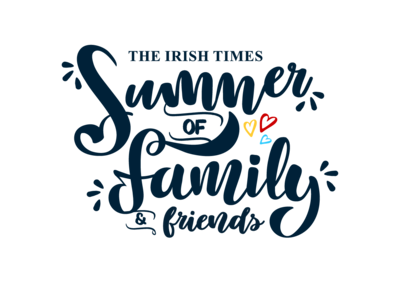
Ciannait Ní Riain Uí Broin runs the play-centred Naíonra Beag preschool in Dublin. She is also a facilitator for the Parents-Plus Early Years Programme and is completing an MA in early intervention in education. Here are her suggestions for activities for preschoolers at home over the summer:
Play
Play is how our children learn and develop, and begin to negotiate the world they are growing up into. This is why the early-years curriculum, Aistear, is play-based and continues from preschool into primary (0-6 years).
Often your child will be happy to find ways to play on their own; other times they may want you to join in, for instance they’ll need customers once they’ve set up shop with all those cans from the cupboards.

A child should always choose their own play freely. Adults need to follow their lead. There is no point in forcing a child to play football in the back garden if all they want to do is paint. By painting alongside them they may invite you to paint something you might like to do. This could be the opportunity to paint a picture of you and them playing ball in the garden, opening up the conversation about going outside to “try it” out.
Reading
There is no greater gift you can give to a child than to read to them. A child who is regularly told or read stories will develop a richer vocabulary, with a better understanding of language, than a child who is not read to. Encourage even very young children to “read” themselves. By looking at the pictures, the child is able to form ideas and creative thoughts, and with a little practice will be able to tell the story as they see it.
Water play
Fill a basin half way with tepid water and a small squirt of washing-up liquid. Add in a few small household items, such as a plastic jug and cup, and some small toys, and let them play. Talk about what floats and sinks. Filling up and pouring water from one utensil to another improves hand-eye co-ordination. Give them a straw and let them play bubbles by blowing through it into the water. This uses the mouth muscles which helps speech development.
Painting and drawing
Attach a large piece of paper or card (even open out a large paper shopping bag) to the wall inside, or to a low window or glass door outside. Standing up to paint or draw helps in the development of faster processing speeds. This is because the child will cross their midline – that is, use their right hand to reach to the left side and vice versa. These movements also develop the proprioceptive system which allows a child to be aware of where their bodies are in relation to the earth or the space they are in.
Finger painting is a great sensory activity that only requires paint and a surface. This does not always have to be paper or card. Most children’s paints are fully washable, so don’t discount painting on household items such as large plates. You can even finger paint on a window with the right supervision.
Try shadow drawing. Take a sheet of paper and a stand-up toy such as a Lego character, farm animal or dinosaur. Stand the toy on the paper in a place (inside or out) where a shadow will form, then go behind the shadow and draw the outline it creates.
Give a child a piece of chalk and they can choose to draw, write, or make a game like hopscotch on a pavement or patio, to be played alone or with others. It’s yet another activity that develops hand-eye co-ordination.
Cleaning windows
This is a chore children love. All you need is a child-level glass door or window, some warm soapy water and a sponge, and off you go. It’s always fun to draw with a finger in the bubbles, and there’s an added sense of value when a child gets to do something to “help” their parent or carer. This is another activity that helps with the development of processing speeds.
Lego
Lego is one of the most versatile toys ever created. Even for the youngest of children they can be placed into a container and shaken to make a rattle. Children enjoy sorting into colours, or brick shape, as well as building. In addition to honing motor skills, Lego encourages imaginative play which helps develop creative ways to solve and invent situations.
Jigsaws
Puzzles are a fantastic way to learn problem solving in addition to helping with hand-eye co-ordination and matching skills. The feeling of achievement in the completion of a jigsaw helps to improve self-esteem.
Build a zoo
A child can use teddies, soft toys and figures to create their own zoo in the garden or indoors, using spaces to mimic wild habitats, eg, sharks/fish/turtles could go in a basin of water. Ask for a tour when they are finished, so you can both discuss the animals.
Leaf pictures
Gather different leaves from your garden or when out for the daily walk. These can be used to glue into patterns on paper, or to form the first letter of their name in leaves. This both connects the child with the natural environment and develops their pre-literacy skills (symbol recognition).
Blow painting
Place a small amount of paint into a container/cup. Dip a straw into the paint and then blow the paint out on to paper to create a masterpiece. Use just one colour at first, and then add more when the child grasps the technique. This develops the mouth muscles, and hand-eye coordination.
Play dough
There are recipes for this on the internet. It’s cheap to make and provides endless enjoyment. It’s a great opportunity for bonding and playing with the dough is therapeutic, in addition to developing fine motor skills and creative thought.
Have fun.




















